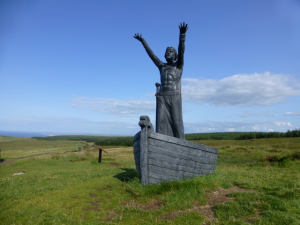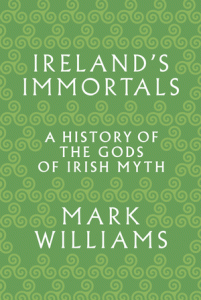Book Review – Ireland’s Immortals: A History of the Gods of Irish Myth
Published by Princeton University Press, 2016.
Pp. 608. €36.99. ISBN 978-0691157313.
Reviewer Caroline Hurley
I could have done with Mark Williams’ latest book last year while writing a piece for a local history magazine about my seventeenth-century ancestor, the Killarney poet and chieftain, Geoffrey O’Donoghue of the Glen. He was trained as a file and wrote in the metre of the time, particularly the intricate dán díreach style. This dimension of Irish life is mentioned repeatedly in Ireland’s Immortals: A History of The Gods of Irish Myth, written by Mark Williams.
O’Donoghue’s poetry teems with references to past Munster kings and also to mythological figures such as Oisin and Conn, which are difficult to tease out without relying on an adept such as Williams. Numerous sources informed me that Irish chieftains descended from the earliest continuous rulers of Ireland, the Milesians, which rendered me dangerously starry-eyed, just as many would-be interpreters before me were affected by the ancient tales.
Williams’ book is a history of ancient Irish pagan religion and mythology.
Following a guide to Irish pronunciation and an illustration list, Williams provides an overview of the book in his preface. Near the end is an extensive index, glossary of terms and impressively long list of works cited, also presented in footnotes. Acknowledgements of people like Roy Foster and Declan Kibard, authorities on Ireland’s culture, and of institutions, including museums and colleges, are also extensive. Perhaps the most intriguing appended section is the Conspectus of Medieval Sources, containing titles and summaries of extant texts of stories generally believed to have been previously passed on orally and dating from the seventh to the fifteenth century. File like O’Donoghue, who doubled as seers, may have studied copies.
Among them is the eleventh-century Book of Invasions, detailing a series of invaders and settlers from Noah’s era until the arrival of Mil Espania, husband of Scotia, father of Amairgen, Heber and Hereman, and grandson of Bregan of Brigantia. When Mil was killed on shore, Scotia and sons returned with an army and conquered the Tuatha Dé Danann. Mil’s ancestors have ruled Ireland ever since. Williams classifies this Lebor Gabála Érenn as proto-history, framed to deliver a genealogy that showed the latest rulers in their best light.

Propaganda, in other words! But not only propaganda, as the raw material of prior figures, battles and locations still shines through. Saint Patrick and fellow saints often feature, as subsequent writers made Christianity play a major part in otherwise pagan tales of former hero-gods.
These changes conformed to the new religious dominance that predated the surviving manuscripts of all the medieval tales. Destroyed texts or spoken forms on which they are based can only be guessed at, considering the variety of amendments, sometimes critical, seen in cases where two or more versions remain.
Williams explores a further fourteen such documents, including The Voyage of Bran, The Second Battle of Moytura, Cormac’s Glossary (Cormac of Cashel was a King-Bishop, straddling spiritual and temporal realms) and The Colloquy of the Elders. The fact that his specialty is literature rather than history is evident in how Williams analyses structure and language, along with veracity and derivation. He appreciates the nuances and multiple imaginations that went into these compositions.
Williams’ specialty is literature and this is evident in how he analyses structure and language
Mark Williams teaches medieval English, Welsh and Irish at Oxford University and he would already have encountered some of the myths identified while researching his earlier book, Fiery Shapes: Celestial Portents and Astrology in Ireland and Wales, 700-1700. He also traces commonalities between myths in Wales, Scotland, and the Isle of Man, primary home of the popular sea god, Manannán Mac Lir. He reveals that, because Irish is categorised as one of the many Indo-European languages, writers such as George Russell tried to identify parallels between Ireland and India too.
The first half of Ireland’s Immortals excavates with every available tool the ancient texts, central to which are the sidhe, or fairy mounds. These fairies were equated with the Tuatha Dé Danann folk: largely invented pagans of the elements who were banished underground with the advent of Christianity just as, in the approved written works, they were demoted from divine beings to merely literary and often silly characters.
This state of affairs continued until the nineteenth century, after the Great Famine, when the Celtic Revivalists, hungry for a prouder sense of national identity, rummaged into the past for inspiration and not only rediscovered the old myths but often revamped and extended them too.
The second half of Williams’ book is concerned with this infatuation for regeneration. Yeats, Lady Gregory and Russell were the key writers in Ireland, followed by Liam O’Flaherty and Austin Clarke, but fascination with everything Celtic fired up artists around the world.
Some got quite carried away with their inventions and Druidic idioms, considerably muddying the waters, as with Scotsman William Sharp’s prolific works, published under the pseudonym Fiona MacLeod. Also capitalising on the trend, Ella Young published self-devised Irish legends before emigrating to California where she lectured on Celtic mythology and established a pagan society called The Fellowship of Mount Shasta. In other cases, enduring works of entertainment were created, such as J. R. R. Tolkien’s classics, musical pieces by composers like England’s Arnold Bax, and visual art by Scotsman John Duncan, and others.
Ireland’s Immortals is a terrific achievement, and of enormous importance for understanding the genesis and influence of myth and its significant and repeated manipulation
Before closing, Williams reflects on the prevailing status of Ireland’s mythological figures. In Derry in 2015, a sculpture of Mannanán mac Lír was irreparably damaged and replaced by a sign which read, ‘ye shall have no other Gods before me’. The indignant public response to this ideological destruction demonstrates how dearly at least some legends are cherished.
Williams singles out Brigit, whose twin is the early Christian nun-saint of the same name from Kildare town, as particularly symbolic of many aspects of combined divine and pagan power. Her feast day, Imbolc, the beginning of Spring, is acknowledged around the world. A proper biography of her in all her guises is overdue, according to Williams. The dynamic incorporation of the war-goddess, Morrigan and other archetypes from Ireland’s senchas into fiction for young adults and children has also been successful, serving as another survival aid.
The last word is saved for the contemporary philosopher John Moriarty, bringing us back to his native Kerry where, after various sojourns, he died in 2007. Williams evaluates his colossal confessional body of work as prescient, with its emphasis on the need for reconciliation with our pagan pasts and their integration with evolved morality in order to confront dire modern risks posed to our shared mental and physical environments.
It is amazing what you see when you step back, and this enlarged vision is what Williams helps us to gain in surveying prominent narratives of the country, which have fed on themselves, pinched morsels from elsewhere and put out shoots. Ireland’s Immortals is a terrific achievement, and of enormous importance for understanding the genesis and influence of myth and its significant and repeated manipulation, in the lives of Irish people who came before us, and in our own twenty-first-century lives.
